Teaching, Learning, and Assessment: Meeting Needs in UK Education
VerifiedAdded on 2023/06/15
|17
|3766
|367
Essay
AI Summary
This essay delves into the critical role of assessment in teaching and learning, focusing on various assessment methods and their impact on learners. The author, acting as a teacher in Essex, UK, observed and identified learner challenges, emphasizing the importance of initial and diagnostic assessments in understanding students' prior knowledge and individual learning needs. The essay explores ten different types of assessment, analyzing their effectiveness in improving student outcomes, and discusses communication theories and their impact on learning. It highlights the benefits of formative assessments and the importance of feedback in motivating students, while also examining the role of teachers in clarifying learning plans and criteria. The work concludes by underscoring the significance of tailored instruction and classroom organization in meeting the diverse needs of all learners, promoting talent development, and fostering a positive learning environment.
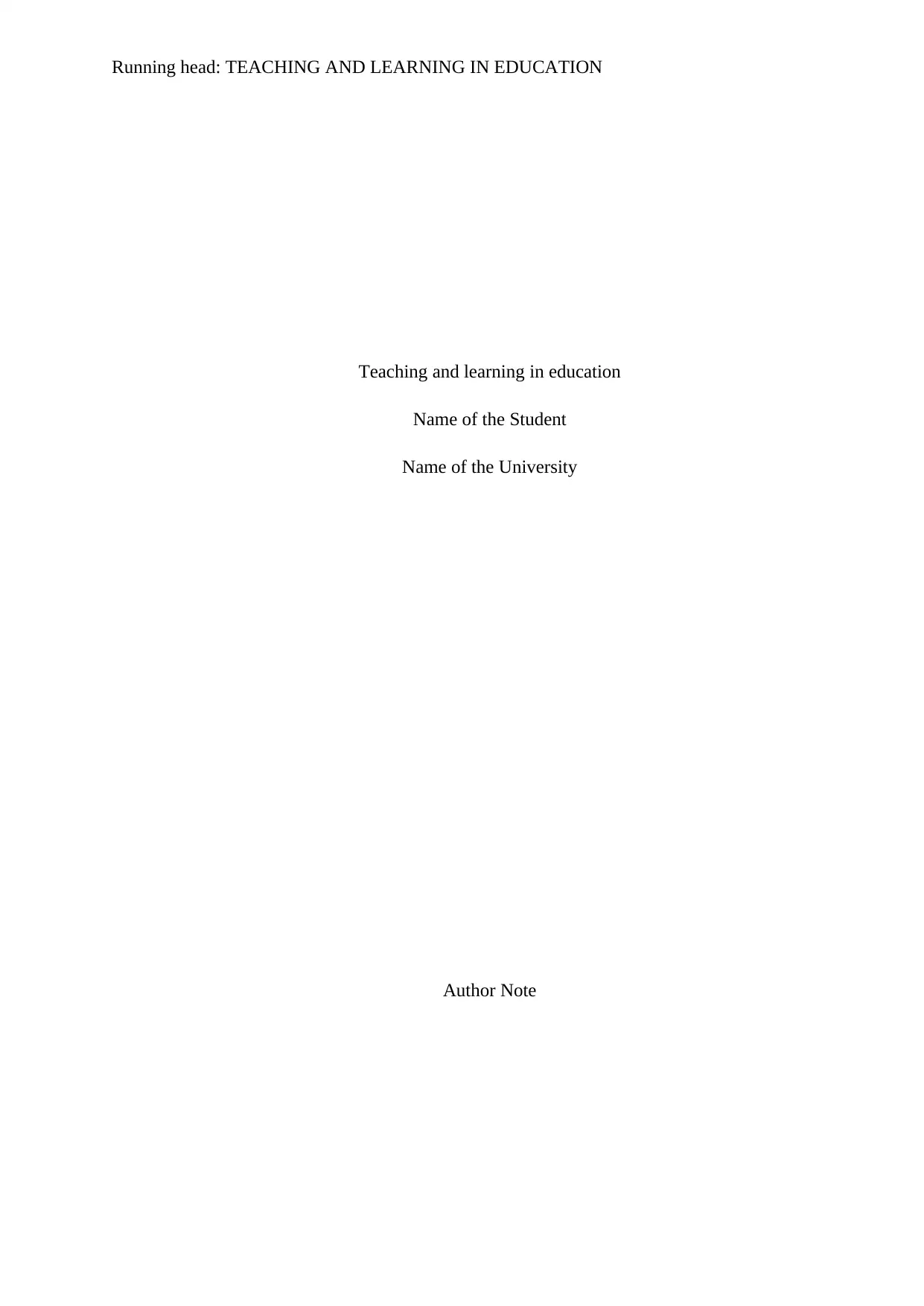
Running head: TEACHING AND LEARNING IN EDUCATION
Teaching and learning in education
Name of the Student
Name of the University
Author Note
Teaching and learning in education
Name of the Student
Name of the University
Author Note
Paraphrase This Document
Need a fresh take? Get an instant paraphrase of this document with our AI Paraphraser
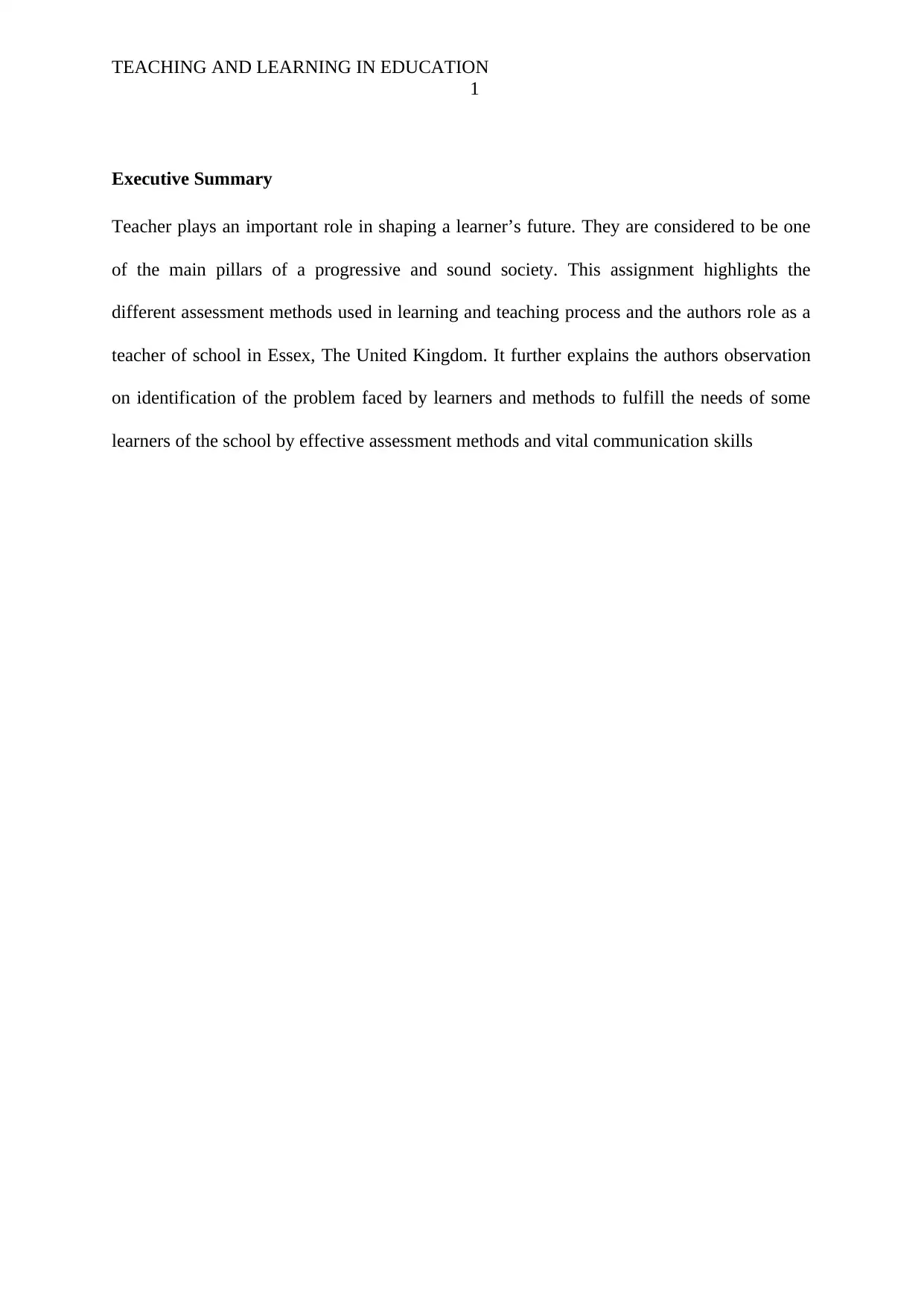
TEACHING AND LEARNING IN EDUCATION
1
Executive Summary
Teacher plays an important role in shaping a learner’s future. They are considered to be one
of the main pillars of a progressive and sound society. This assignment highlights the
different assessment methods used in learning and teaching process and the authors role as a
teacher of school in Essex, The United Kingdom. It further explains the authors observation
on identification of the problem faced by learners and methods to fulfill the needs of some
learners of the school by effective assessment methods and vital communication skills
1
Executive Summary
Teacher plays an important role in shaping a learner’s future. They are considered to be one
of the main pillars of a progressive and sound society. This assignment highlights the
different assessment methods used in learning and teaching process and the authors role as a
teacher of school in Essex, The United Kingdom. It further explains the authors observation
on identification of the problem faced by learners and methods to fulfill the needs of some
learners of the school by effective assessment methods and vital communication skills
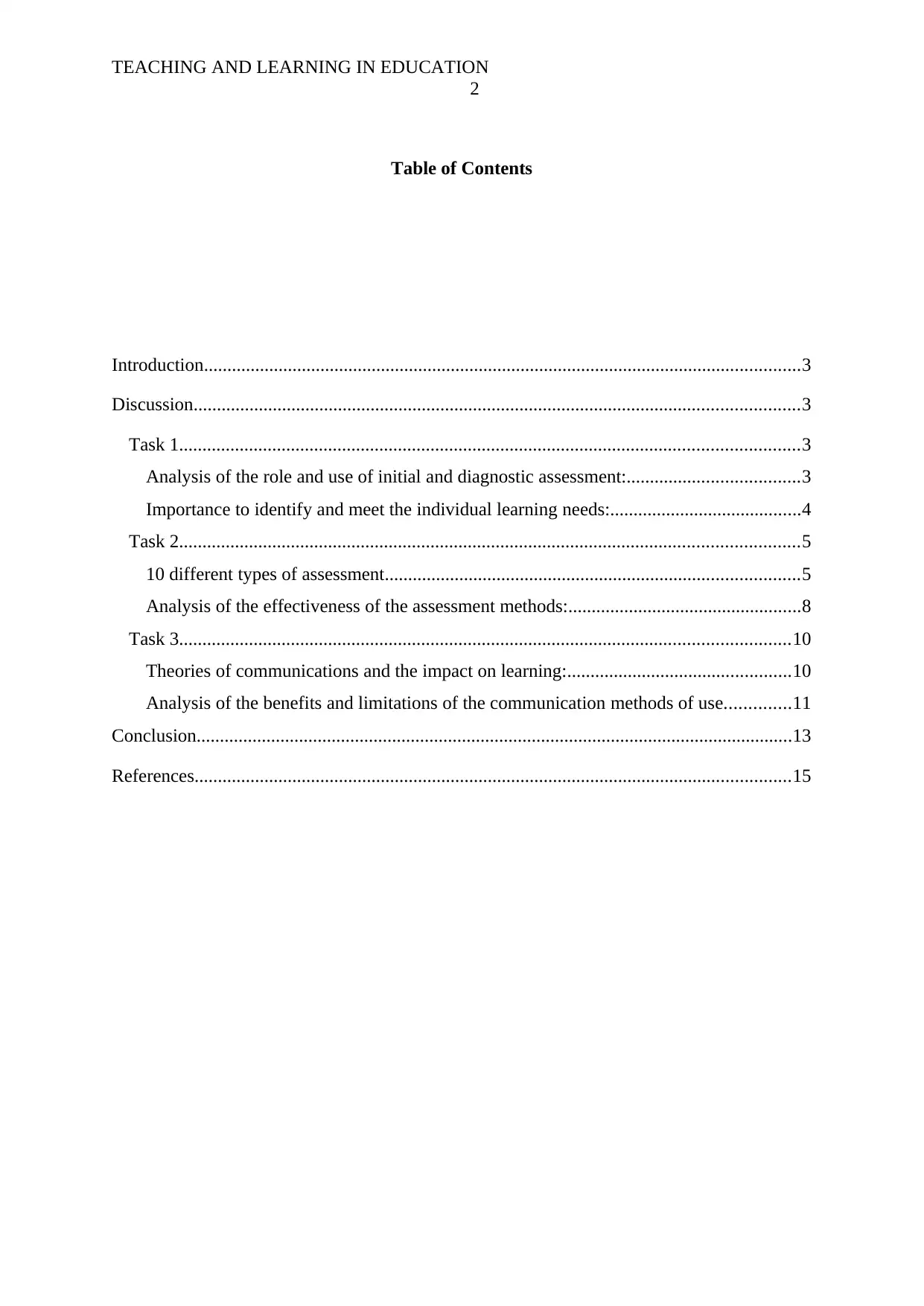
TEACHING AND LEARNING IN EDUCATION
2
Table of Contents
Introduction................................................................................................................................3
Discussion..................................................................................................................................3
Task 1.....................................................................................................................................3
Analysis of the role and use of initial and diagnostic assessment:.....................................3
Importance to identify and meet the individual learning needs:.........................................4
Task 2.....................................................................................................................................5
10 different types of assessment.........................................................................................5
Analysis of the effectiveness of the assessment methods:..................................................8
Task 3...................................................................................................................................10
Theories of communications and the impact on learning:................................................10
Analysis of the benefits and limitations of the communication methods of use..............11
Conclusion................................................................................................................................13
References................................................................................................................................15
2
Table of Contents
Introduction................................................................................................................................3
Discussion..................................................................................................................................3
Task 1.....................................................................................................................................3
Analysis of the role and use of initial and diagnostic assessment:.....................................3
Importance to identify and meet the individual learning needs:.........................................4
Task 2.....................................................................................................................................5
10 different types of assessment.........................................................................................5
Analysis of the effectiveness of the assessment methods:..................................................8
Task 3...................................................................................................................................10
Theories of communications and the impact on learning:................................................10
Analysis of the benefits and limitations of the communication methods of use..............11
Conclusion................................................................................................................................13
References................................................................................................................................15
⊘ This is a preview!⊘
Do you want full access?
Subscribe today to unlock all pages.

Trusted by 1+ million students worldwide
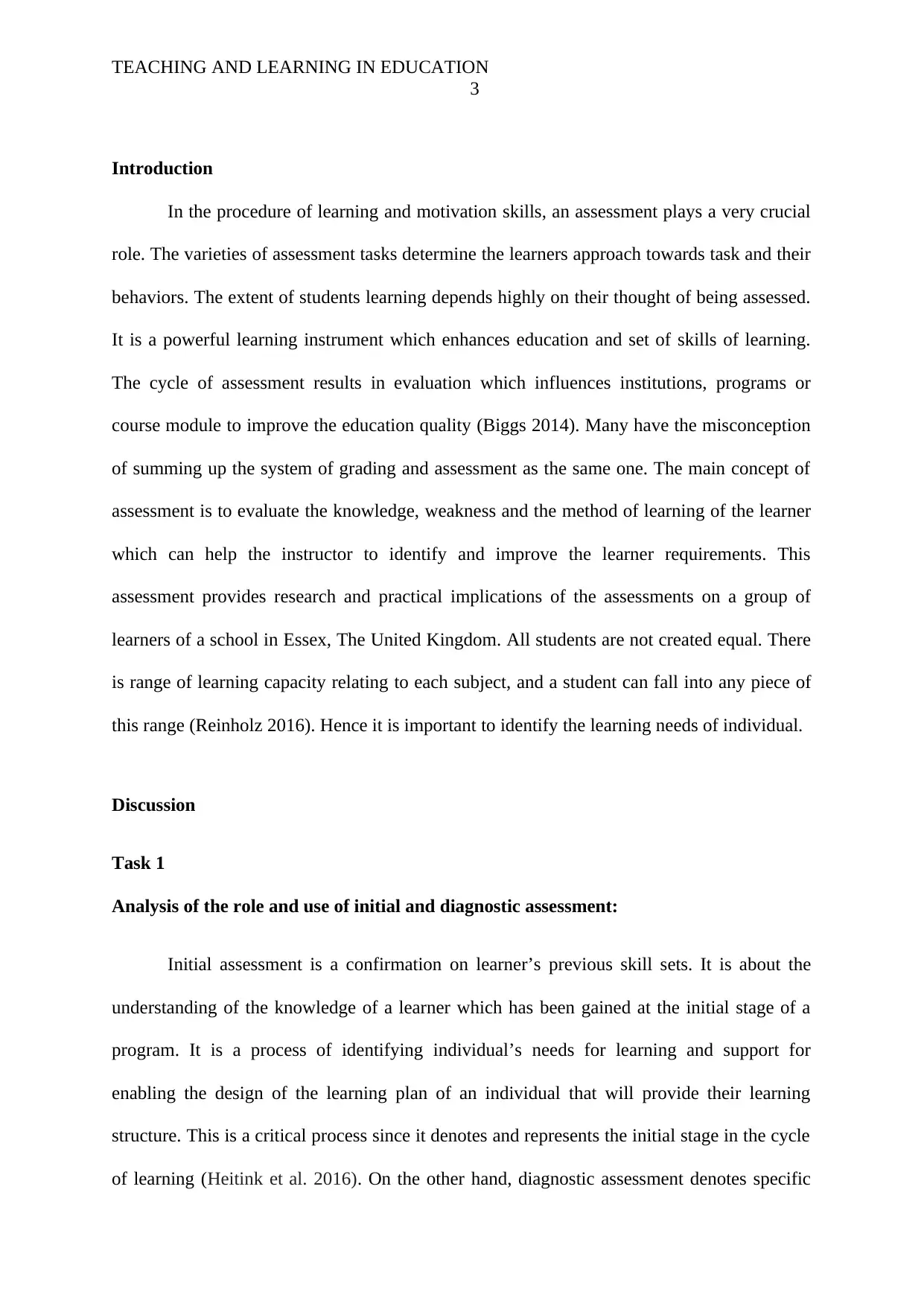
TEACHING AND LEARNING IN EDUCATION
3
Introduction
In the procedure of learning and motivation skills, an assessment plays a very crucial
role. The varieties of assessment tasks determine the learners approach towards task and their
behaviors. The extent of students learning depends highly on their thought of being assessed.
It is a powerful learning instrument which enhances education and set of skills of learning.
The cycle of assessment results in evaluation which influences institutions, programs or
course module to improve the education quality (Biggs 2014). Many have the misconception
of summing up the system of grading and assessment as the same one. The main concept of
assessment is to evaluate the knowledge, weakness and the method of learning of the learner
which can help the instructor to identify and improve the learner requirements. This
assessment provides research and practical implications of the assessments on a group of
learners of a school in Essex, The United Kingdom. All students are not created equal. There
is range of learning capacity relating to each subject, and a student can fall into any piece of
this range (Reinholz 2016). Hence it is important to identify the learning needs of individual.
Discussion
Task 1
Analysis of the role and use of initial and diagnostic assessment:
Initial assessment is a confirmation on learner’s previous skill sets. It is about the
understanding of the knowledge of a learner which has been gained at the initial stage of a
program. It is a process of identifying individual’s needs for learning and support for
enabling the design of the learning plan of an individual that will provide their learning
structure. This is a critical process since it denotes and represents the initial stage in the cycle
of learning (Heitink et al. 2016). On the other hand, diagnostic assessment denotes specific
3
Introduction
In the procedure of learning and motivation skills, an assessment plays a very crucial
role. The varieties of assessment tasks determine the learners approach towards task and their
behaviors. The extent of students learning depends highly on their thought of being assessed.
It is a powerful learning instrument which enhances education and set of skills of learning.
The cycle of assessment results in evaluation which influences institutions, programs or
course module to improve the education quality (Biggs 2014). Many have the misconception
of summing up the system of grading and assessment as the same one. The main concept of
assessment is to evaluate the knowledge, weakness and the method of learning of the learner
which can help the instructor to identify and improve the learner requirements. This
assessment provides research and practical implications of the assessments on a group of
learners of a school in Essex, The United Kingdom. All students are not created equal. There
is range of learning capacity relating to each subject, and a student can fall into any piece of
this range (Reinholz 2016). Hence it is important to identify the learning needs of individual.
Discussion
Task 1
Analysis of the role and use of initial and diagnostic assessment:
Initial assessment is a confirmation on learner’s previous skill sets. It is about the
understanding of the knowledge of a learner which has been gained at the initial stage of a
program. It is a process of identifying individual’s needs for learning and support for
enabling the design of the learning plan of an individual that will provide their learning
structure. This is a critical process since it denotes and represents the initial stage in the cycle
of learning (Heitink et al. 2016). On the other hand, diagnostic assessment denotes specific
Paraphrase This Document
Need a fresh take? Get an instant paraphrase of this document with our AI Paraphraser
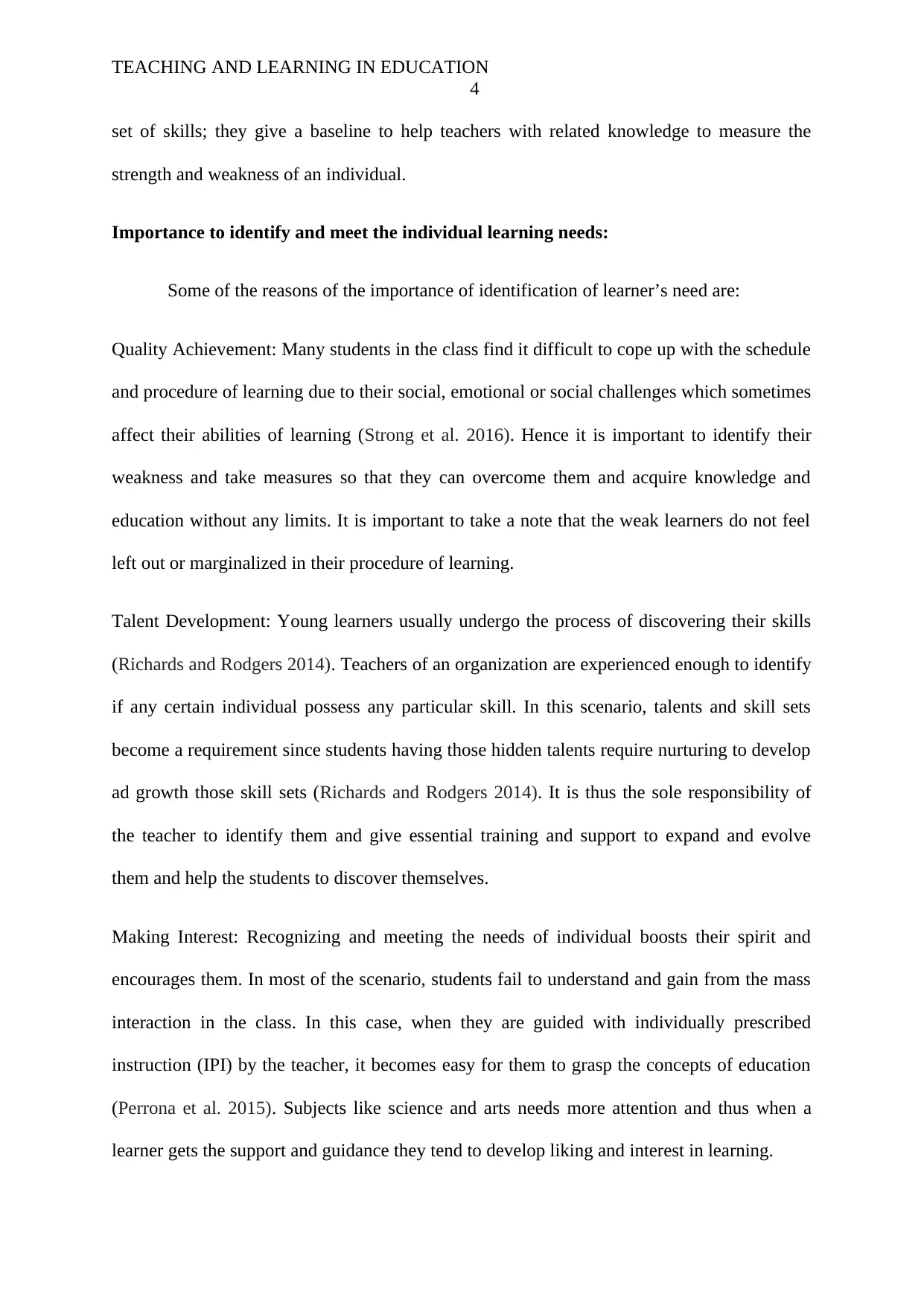
TEACHING AND LEARNING IN EDUCATION
4
set of skills; they give a baseline to help teachers with related knowledge to measure the
strength and weakness of an individual.
Importance to identify and meet the individual learning needs:
Some of the reasons of the importance of identification of learner’s need are:
Quality Achievement: Many students in the class find it difficult to cope up with the schedule
and procedure of learning due to their social, emotional or social challenges which sometimes
affect their abilities of learning (Strong et al. 2016). Hence it is important to identify their
weakness and take measures so that they can overcome them and acquire knowledge and
education without any limits. It is important to take a note that the weak learners do not feel
left out or marginalized in their procedure of learning.
Talent Development: Young learners usually undergo the process of discovering their skills
(Richards and Rodgers 2014). Teachers of an organization are experienced enough to identify
if any certain individual possess any particular skill. In this scenario, talents and skill sets
become a requirement since students having those hidden talents require nurturing to develop
ad growth those skill sets (Richards and Rodgers 2014). It is thus the sole responsibility of
the teacher to identify them and give essential training and support to expand and evolve
them and help the students to discover themselves.
Making Interest: Recognizing and meeting the needs of individual boosts their spirit and
encourages them. In most of the scenario, students fail to understand and gain from the mass
interaction in the class. In this case, when they are guided with individually prescribed
instruction (IPI) by the teacher, it becomes easy for them to grasp the concepts of education
(Perrona et al. 2015). Subjects like science and arts needs more attention and thus when a
learner gets the support and guidance they tend to develop liking and interest in learning.
4
set of skills; they give a baseline to help teachers with related knowledge to measure the
strength and weakness of an individual.
Importance to identify and meet the individual learning needs:
Some of the reasons of the importance of identification of learner’s need are:
Quality Achievement: Many students in the class find it difficult to cope up with the schedule
and procedure of learning due to their social, emotional or social challenges which sometimes
affect their abilities of learning (Strong et al. 2016). Hence it is important to identify their
weakness and take measures so that they can overcome them and acquire knowledge and
education without any limits. It is important to take a note that the weak learners do not feel
left out or marginalized in their procedure of learning.
Talent Development: Young learners usually undergo the process of discovering their skills
(Richards and Rodgers 2014). Teachers of an organization are experienced enough to identify
if any certain individual possess any particular skill. In this scenario, talents and skill sets
become a requirement since students having those hidden talents require nurturing to develop
ad growth those skill sets (Richards and Rodgers 2014). It is thus the sole responsibility of
the teacher to identify them and give essential training and support to expand and evolve
them and help the students to discover themselves.
Making Interest: Recognizing and meeting the needs of individual boosts their spirit and
encourages them. In most of the scenario, students fail to understand and gain from the mass
interaction in the class. In this case, when they are guided with individually prescribed
instruction (IPI) by the teacher, it becomes easy for them to grasp the concepts of education
(Perrona et al. 2015). Subjects like science and arts needs more attention and thus when a
learner gets the support and guidance they tend to develop liking and interest in learning.
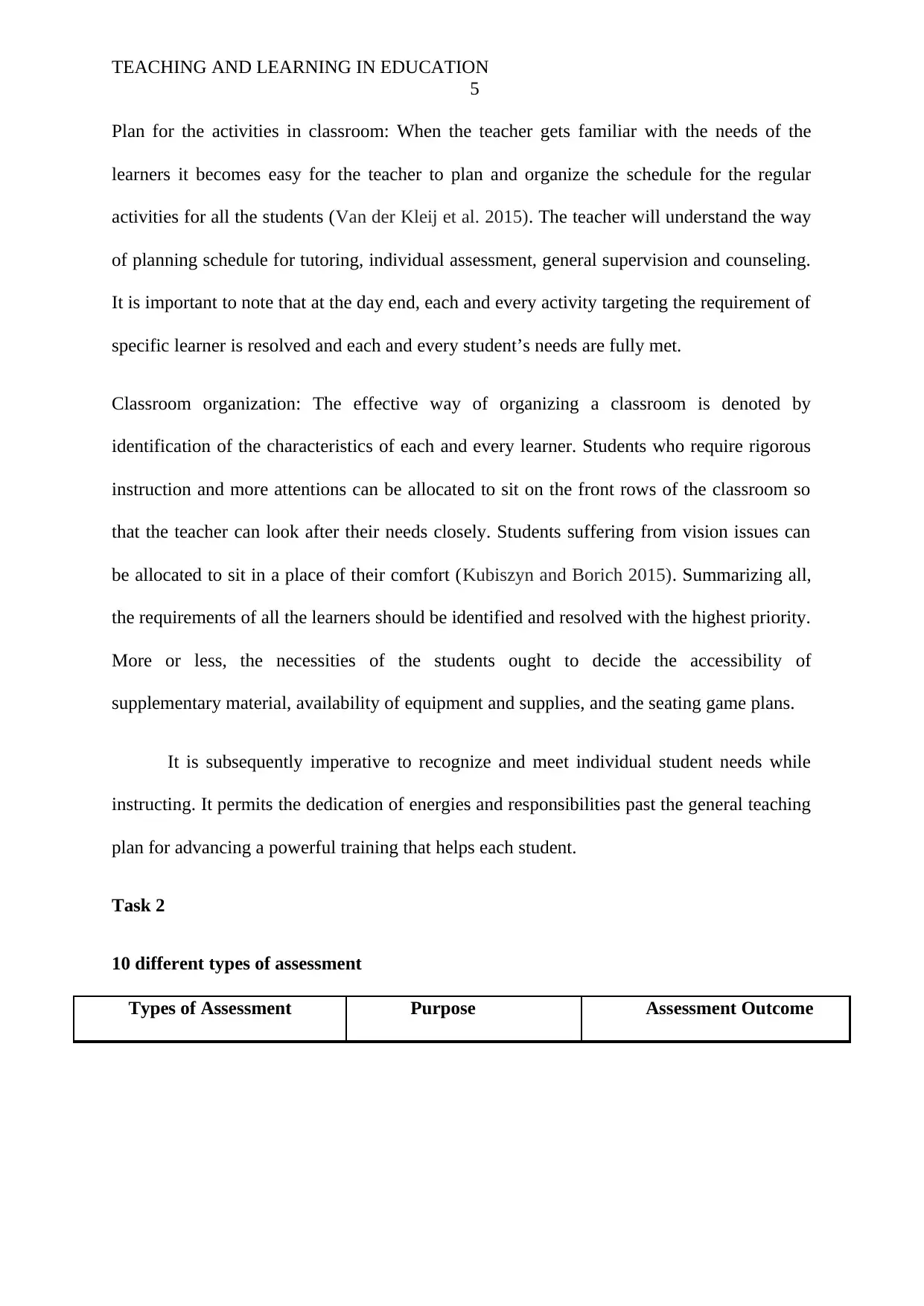
TEACHING AND LEARNING IN EDUCATION
5
Plan for the activities in classroom: When the teacher gets familiar with the needs of the
learners it becomes easy for the teacher to plan and organize the schedule for the regular
activities for all the students (Van der Kleij et al. 2015). The teacher will understand the way
of planning schedule for tutoring, individual assessment, general supervision and counseling.
It is important to note that at the day end, each and every activity targeting the requirement of
specific learner is resolved and each and every student’s needs are fully met.
Classroom organization: The effective way of organizing a classroom is denoted by
identification of the characteristics of each and every learner. Students who require rigorous
instruction and more attentions can be allocated to sit on the front rows of the classroom so
that the teacher can look after their needs closely. Students suffering from vision issues can
be allocated to sit in a place of their comfort (Kubiszyn and Borich 2015). Summarizing all,
the requirements of all the learners should be identified and resolved with the highest priority.
More or less, the necessities of the students ought to decide the accessibility of
supplementary material, availability of equipment and supplies, and the seating game plans.
It is subsequently imperative to recognize and meet individual student needs while
instructing. It permits the dedication of energies and responsibilities past the general teaching
plan for advancing a powerful training that helps each student.
Task 2
10 different types of assessment
Types of Assessment Purpose Assessment Outcome
5
Plan for the activities in classroom: When the teacher gets familiar with the needs of the
learners it becomes easy for the teacher to plan and organize the schedule for the regular
activities for all the students (Van der Kleij et al. 2015). The teacher will understand the way
of planning schedule for tutoring, individual assessment, general supervision and counseling.
It is important to note that at the day end, each and every activity targeting the requirement of
specific learner is resolved and each and every student’s needs are fully met.
Classroom organization: The effective way of organizing a classroom is denoted by
identification of the characteristics of each and every learner. Students who require rigorous
instruction and more attentions can be allocated to sit on the front rows of the classroom so
that the teacher can look after their needs closely. Students suffering from vision issues can
be allocated to sit in a place of their comfort (Kubiszyn and Borich 2015). Summarizing all,
the requirements of all the learners should be identified and resolved with the highest priority.
More or less, the necessities of the students ought to decide the accessibility of
supplementary material, availability of equipment and supplies, and the seating game plans.
It is subsequently imperative to recognize and meet individual student needs while
instructing. It permits the dedication of energies and responsibilities past the general teaching
plan for advancing a powerful training that helps each student.
Task 2
10 different types of assessment
Types of Assessment Purpose Assessment Outcome
⊘ This is a preview!⊘
Do you want full access?
Subscribe today to unlock all pages.

Trusted by 1+ million students worldwide
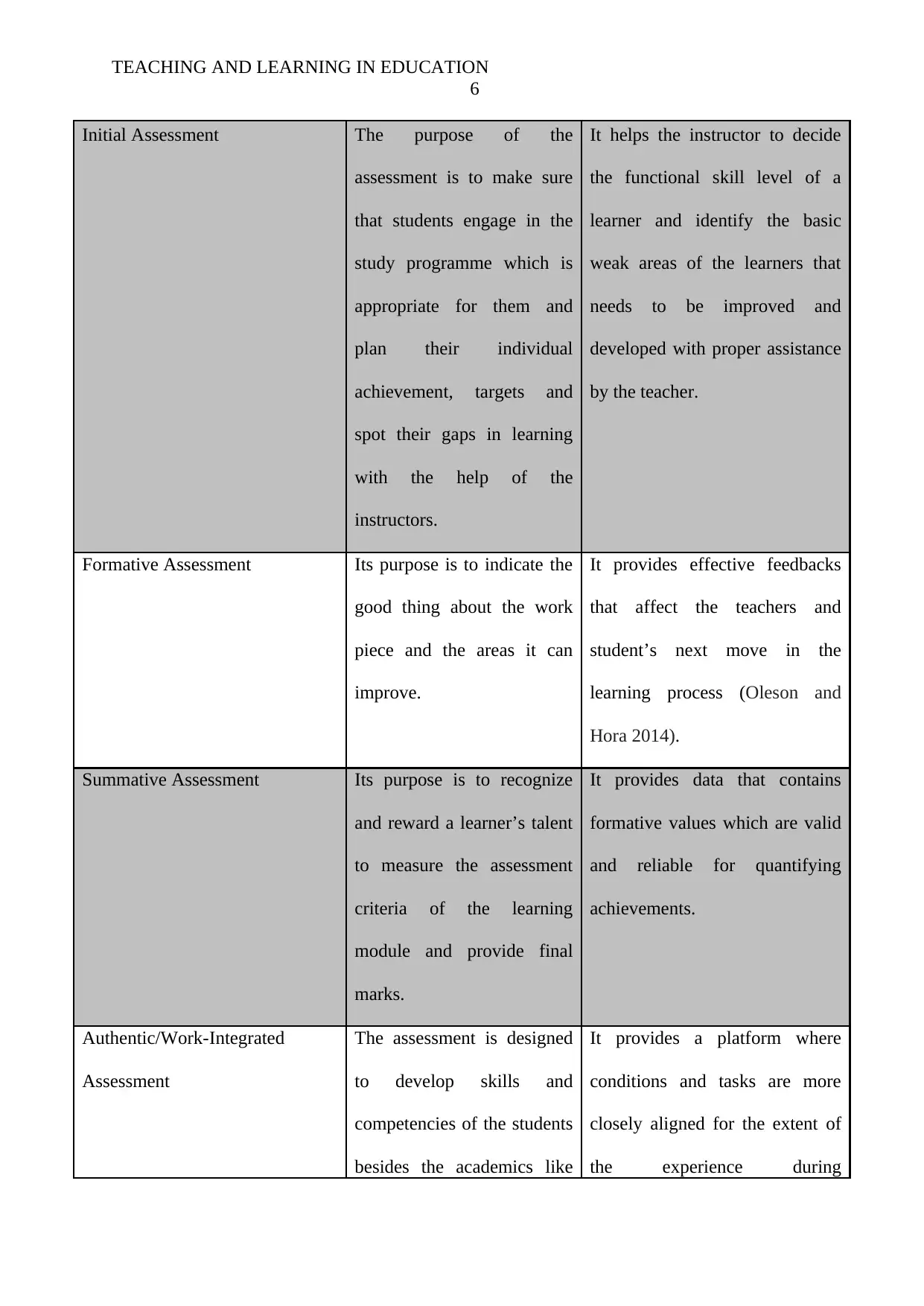
TEACHING AND LEARNING IN EDUCATION
6
Initial Assessment The purpose of the
assessment is to make sure
that students engage in the
study programme which is
appropriate for them and
plan their individual
achievement, targets and
spot their gaps in learning
with the help of the
instructors.
It helps the instructor to decide
the functional skill level of a
learner and identify the basic
weak areas of the learners that
needs to be improved and
developed with proper assistance
by the teacher.
Formative Assessment Its purpose is to indicate the
good thing about the work
piece and the areas it can
improve.
It provides effective feedbacks
that affect the teachers and
student’s next move in the
learning process (Oleson and
Hora 2014).
Summative Assessment Its purpose is to recognize
and reward a learner’s talent
to measure the assessment
criteria of the learning
module and provide final
marks.
It provides data that contains
formative values which are valid
and reliable for quantifying
achievements.
Authentic/Work-Integrated
Assessment
The assessment is designed
to develop skills and
competencies of the students
besides the academics like
It provides a platform where
conditions and tasks are more
closely aligned for the extent of
the experience during
6
Initial Assessment The purpose of the
assessment is to make sure
that students engage in the
study programme which is
appropriate for them and
plan their individual
achievement, targets and
spot their gaps in learning
with the help of the
instructors.
It helps the instructor to decide
the functional skill level of a
learner and identify the basic
weak areas of the learners that
needs to be improved and
developed with proper assistance
by the teacher.
Formative Assessment Its purpose is to indicate the
good thing about the work
piece and the areas it can
improve.
It provides effective feedbacks
that affect the teachers and
student’s next move in the
learning process (Oleson and
Hora 2014).
Summative Assessment Its purpose is to recognize
and reward a learner’s talent
to measure the assessment
criteria of the learning
module and provide final
marks.
It provides data that contains
formative values which are valid
and reliable for quantifying
achievements.
Authentic/Work-Integrated
Assessment
The assessment is designed
to develop skills and
competencies of the students
besides the academics like
It provides a platform where
conditions and tasks are more
closely aligned for the extent of
the experience during
Paraphrase This Document
Need a fresh take? Get an instant paraphrase of this document with our AI Paraphraser
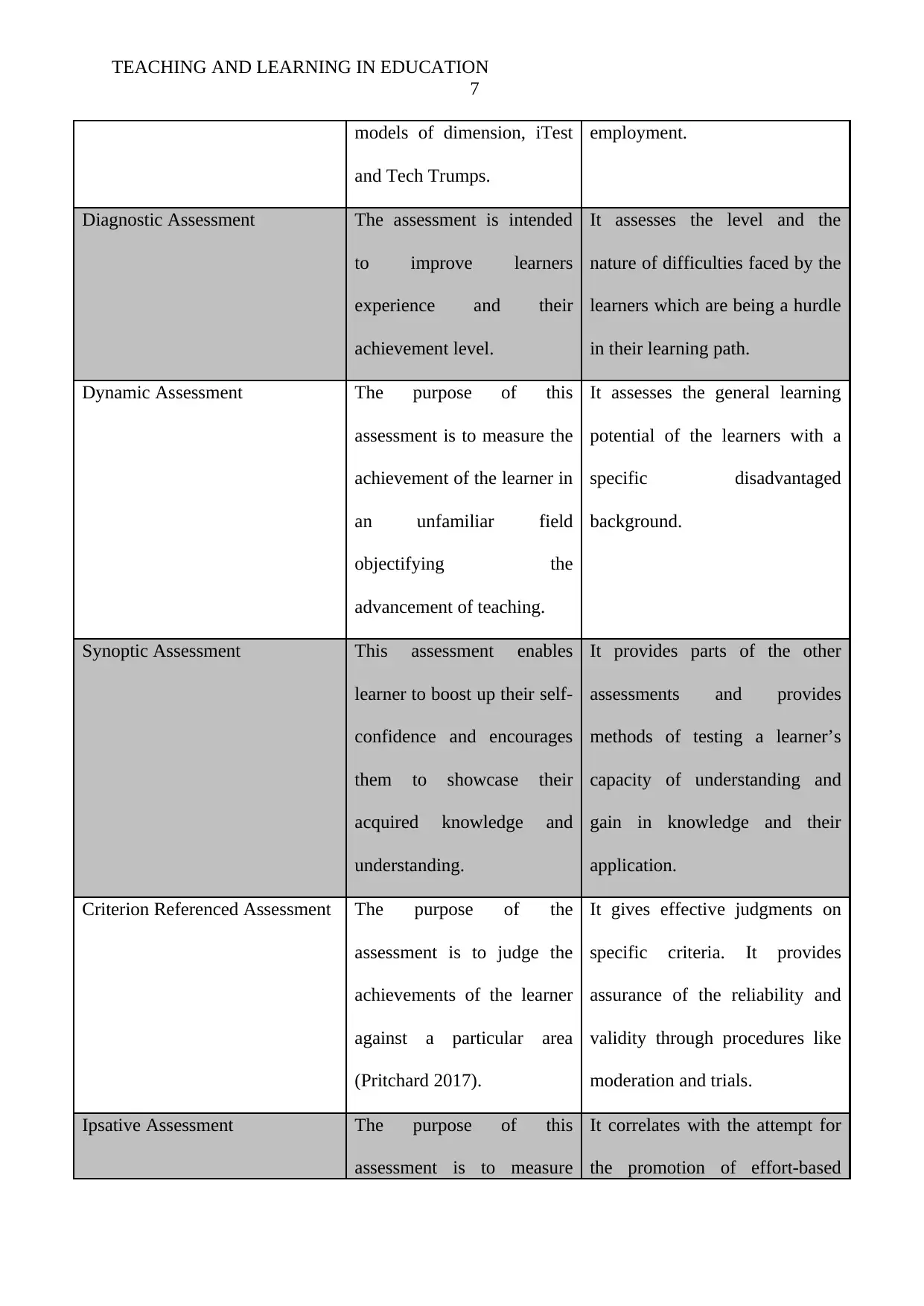
TEACHING AND LEARNING IN EDUCATION
7
models of dimension, iTest
and Tech Trumps.
employment.
Diagnostic Assessment The assessment is intended
to improve learners
experience and their
achievement level.
It assesses the level and the
nature of difficulties faced by the
learners which are being a hurdle
in their learning path.
Dynamic Assessment The purpose of this
assessment is to measure the
achievement of the learner in
an unfamiliar field
objectifying the
advancement of teaching.
It assesses the general learning
potential of the learners with a
specific disadvantaged
background.
Synoptic Assessment This assessment enables
learner to boost up their self-
confidence and encourages
them to showcase their
acquired knowledge and
understanding.
It provides parts of the other
assessments and provides
methods of testing a learner’s
capacity of understanding and
gain in knowledge and their
application.
Criterion Referenced Assessment The purpose of the
assessment is to judge the
achievements of the learner
against a particular area
(Pritchard 2017).
It gives effective judgments on
specific criteria. It provides
assurance of the reliability and
validity through procedures like
moderation and trials.
Ipsative Assessment The purpose of this
assessment is to measure
It correlates with the attempt for
the promotion of effort-based
7
models of dimension, iTest
and Tech Trumps.
employment.
Diagnostic Assessment The assessment is intended
to improve learners
experience and their
achievement level.
It assesses the level and the
nature of difficulties faced by the
learners which are being a hurdle
in their learning path.
Dynamic Assessment The purpose of this
assessment is to measure the
achievement of the learner in
an unfamiliar field
objectifying the
advancement of teaching.
It assesses the general learning
potential of the learners with a
specific disadvantaged
background.
Synoptic Assessment This assessment enables
learner to boost up their self-
confidence and encourages
them to showcase their
acquired knowledge and
understanding.
It provides parts of the other
assessments and provides
methods of testing a learner’s
capacity of understanding and
gain in knowledge and their
application.
Criterion Referenced Assessment The purpose of the
assessment is to judge the
achievements of the learner
against a particular area
(Pritchard 2017).
It gives effective judgments on
specific criteria. It provides
assurance of the reliability and
validity through procedures like
moderation and trials.
Ipsative Assessment The purpose of this
assessment is to measure
It correlates with the attempt for
the promotion of effort-based

TEACHING AND LEARNING IN EDUCATION
8
how well a specific task has
been attempted against the
student’s normal
accomplishment, their best
work, or their latest work.
attributions of triumph and to
improve inspiration to learn.
Benchmark/Interim Assessment The purpose of this
assessment is to help
instructors to track learner’s
position towards long term
objectives.
It provides a comparison of a
learners understanding for a set
of uniform standards in a specific
time period.
Analysis of the effectiveness of the assessment methods:
A comprehensive review by Black and Wiliam discovered that formative assessments
brings about impressive learning picks up, among the most significant ones for instructive
intercessions (Shute and Kim 2014). There is boundless confirmation that assessments and
feedbacks are effective powers of learning. Research demonstrates that a feedback that gives
instructive input while a learner is studying has more impact on learner accomplishment than
some other factor (Wilkinson, Boohan and Stevenson 2014). Formative assessment with its
input capacity can emphatically impact inspiration, empowering interest, duty, scholarly test,
freedom and obligation; it is difficult to exaggerate the exact role of feedbacks on the
progress of a student.
Formative assessments have been preferred by teachers throughout the time. Various
sources tout the capacity of these methodologies to enhance understudy scholastic
accomplishment (Shute and Kim 2014). An aspect of a teacher includes the clarification of
8
how well a specific task has
been attempted against the
student’s normal
accomplishment, their best
work, or their latest work.
attributions of triumph and to
improve inspiration to learn.
Benchmark/Interim Assessment The purpose of this
assessment is to help
instructors to track learner’s
position towards long term
objectives.
It provides a comparison of a
learners understanding for a set
of uniform standards in a specific
time period.
Analysis of the effectiveness of the assessment methods:
A comprehensive review by Black and Wiliam discovered that formative assessments
brings about impressive learning picks up, among the most significant ones for instructive
intercessions (Shute and Kim 2014). There is boundless confirmation that assessments and
feedbacks are effective powers of learning. Research demonstrates that a feedback that gives
instructive input while a learner is studying has more impact on learner accomplishment than
some other factor (Wilkinson, Boohan and Stevenson 2014). Formative assessment with its
input capacity can emphatically impact inspiration, empowering interest, duty, scholarly test,
freedom and obligation; it is difficult to exaggerate the exact role of feedbacks on the
progress of a student.
Formative assessments have been preferred by teachers throughout the time. Various
sources tout the capacity of these methodologies to enhance understudy scholastic
accomplishment (Shute and Kim 2014). An aspect of a teacher includes the clarification of
⊘ This is a preview!⊘
Do you want full access?
Subscribe today to unlock all pages.

Trusted by 1+ million students worldwide
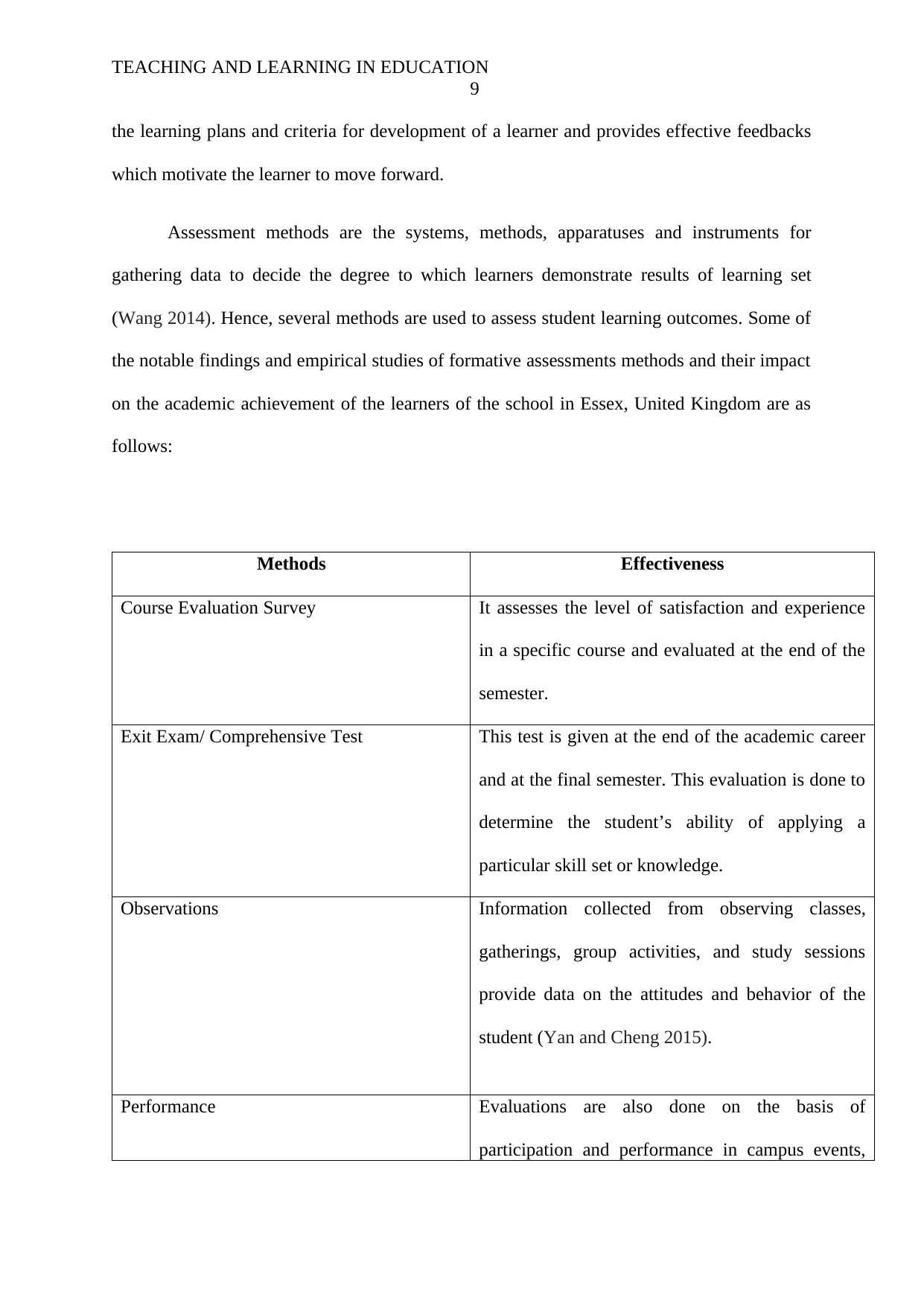
TEACHING AND LEARNING IN EDUCATION
9
the learning plans and criteria for development of a learner and provides effective feedbacks
which motivate the learner to move forward.
Assessment methods are the systems, methods, apparatuses and instruments for
gathering data to decide the degree to which learners demonstrate results of learning set
(Wang 2014). Hence, several methods are used to assess student learning outcomes. Some of
the notable findings and empirical studies of formative assessments methods and their impact
on the academic achievement of the learners of the school in Essex, United Kingdom are as
follows:
Methods Effectiveness
Course Evaluation Survey It assesses the level of satisfaction and experience
in a specific course and evaluated at the end of the
semester.
Exit Exam/ Comprehensive Test This test is given at the end of the academic career
and at the final semester. This evaluation is done to
determine the student’s ability of applying a
particular skill set or knowledge.
Observations Information collected from observing classes,
gatherings, group activities, and study sessions
provide data on the attitudes and behavior of the
student (Yan and Cheng 2015).
Performance Evaluations are also done on the basis of
participation and performance in campus events,
9
the learning plans and criteria for development of a learner and provides effective feedbacks
which motivate the learner to move forward.
Assessment methods are the systems, methods, apparatuses and instruments for
gathering data to decide the degree to which learners demonstrate results of learning set
(Wang 2014). Hence, several methods are used to assess student learning outcomes. Some of
the notable findings and empirical studies of formative assessments methods and their impact
on the academic achievement of the learners of the school in Essex, United Kingdom are as
follows:
Methods Effectiveness
Course Evaluation Survey It assesses the level of satisfaction and experience
in a specific course and evaluated at the end of the
semester.
Exit Exam/ Comprehensive Test This test is given at the end of the academic career
and at the final semester. This evaluation is done to
determine the student’s ability of applying a
particular skill set or knowledge.
Observations Information collected from observing classes,
gatherings, group activities, and study sessions
provide data on the attitudes and behavior of the
student (Yan and Cheng 2015).
Performance Evaluations are also done on the basis of
participation and performance in campus events,
Paraphrase This Document
Need a fresh take? Get an instant paraphrase of this document with our AI Paraphraser

TEACHING AND LEARNING IN EDUCATION
10
internships, volunteer works and any other
community performance (Pritchard 2017).
Task 3
Theories of communications and the impact on learning:
Piaget's work on children's scholarly advancement owed much to his initial
investigations of water snails (Jablonka 2017). His views on how a student’s mind works and
creates had an incredible impact particularly in his theory of education. Piaget's hypothesis of
psychological improvement was the focal structure to his theory. The obtaining of
information in youth includes procedures, for example, understanding, thinking, considering,
critical solving, conceptualizing and recollecting, and all parts of human insight that are
utilized to comprehend the world. Piaget's hypothesis allows children in their active learning
so that they acquire knowledge from their faults (Jablonka 2017).
Lev Vygotsky expresses that the capacity in the children’s cultural improvement
shows up twice: initially, between individuals and afterward inside the youngster (Vygotsky
1967). This applies similarly to deliberate consideration, to coherent memory, and to the
arrangement of thoughts. According to his theory, all the higher capacities start as genuine
connections between people.
Basil Bernstein made a huge commitment to the study of Communication with his
sociolinguistic hypothesis of language codes (Bernstein 2000). In a general sense, Bernstein's
latest advancement of his code theory analyzed the general standards hidden in the changes of
learning into academic correspondence (Bernstein 2000).
10
internships, volunteer works and any other
community performance (Pritchard 2017).
Task 3
Theories of communications and the impact on learning:
Piaget's work on children's scholarly advancement owed much to his initial
investigations of water snails (Jablonka 2017). His views on how a student’s mind works and
creates had an incredible impact particularly in his theory of education. Piaget's hypothesis of
psychological improvement was the focal structure to his theory. The obtaining of
information in youth includes procedures, for example, understanding, thinking, considering,
critical solving, conceptualizing and recollecting, and all parts of human insight that are
utilized to comprehend the world. Piaget's hypothesis allows children in their active learning
so that they acquire knowledge from their faults (Jablonka 2017).
Lev Vygotsky expresses that the capacity in the children’s cultural improvement
shows up twice: initially, between individuals and afterward inside the youngster (Vygotsky
1967). This applies similarly to deliberate consideration, to coherent memory, and to the
arrangement of thoughts. According to his theory, all the higher capacities start as genuine
connections between people.
Basil Bernstein made a huge commitment to the study of Communication with his
sociolinguistic hypothesis of language codes (Bernstein 2000). In a general sense, Bernstein's
latest advancement of his code theory analyzed the general standards hidden in the changes of
learning into academic correspondence (Bernstein 2000).

TEACHING AND LEARNING IN EDUCATION
11
Analysis of the benefits and limitations of the communication methods of use
Successful communication skills are extremely essential to educators in their
conveyance of instructional method, classroom administration and association with the class
(Perrona et al. 2015).
Communication is regarded as the process of transmission of information from the
sender to receiver through a medium or channel. Communication happens through channels
(Richards and Rodgers 2014). Skills are applied in the teachers’ classroom administration,
instructional method and communication with the class. The skill set that a tutor has defines
the kind of environment that will be in that person’s classes. The correct sets of skills are
mandatory to have a proper classroom environment. Proper communication between a
student and the teacher is necessary for imparting education that is worthy.
Communication methods used by the author in his working experience as a teacher include
the following:
Method Strengths Limitations
Lecture with Discussion It includes the learners and
the learners can question,
clarify and challenge
different ideas. It encourages
learner for open and vide
discussions. Learners are
allowed and encouraged to
participate in open debates
so that they can express their
The procedure of learning is
difficult for some learners
since it becomes difficult to
gauge the information
received. The communication
process is one way (Kubiszyn
and Borich 2015).
11
Analysis of the benefits and limitations of the communication methods of use
Successful communication skills are extremely essential to educators in their
conveyance of instructional method, classroom administration and association with the class
(Perrona et al. 2015).
Communication is regarded as the process of transmission of information from the
sender to receiver through a medium or channel. Communication happens through channels
(Richards and Rodgers 2014). Skills are applied in the teachers’ classroom administration,
instructional method and communication with the class. The skill set that a tutor has defines
the kind of environment that will be in that person’s classes. The correct sets of skills are
mandatory to have a proper classroom environment. Proper communication between a
student and the teacher is necessary for imparting education that is worthy.
Communication methods used by the author in his working experience as a teacher include
the following:
Method Strengths Limitations
Lecture with Discussion It includes the learners and
the learners can question,
clarify and challenge
different ideas. It encourages
learner for open and vide
discussions. Learners are
allowed and encouraged to
participate in open debates
so that they can express their
The procedure of learning is
difficult for some learners
since it becomes difficult to
gauge the information
received. The communication
process is one way (Kubiszyn
and Borich 2015).
⊘ This is a preview!⊘
Do you want full access?
Subscribe today to unlock all pages.

Trusted by 1+ million students worldwide
1 out of 17
Related Documents
Your All-in-One AI-Powered Toolkit for Academic Success.
+13062052269
info@desklib.com
Available 24*7 on WhatsApp / Email
![[object Object]](/_next/static/media/star-bottom.7253800d.svg)
Unlock your academic potential
Copyright © 2020–2025 A2Z Services. All Rights Reserved. Developed and managed by ZUCOL.




